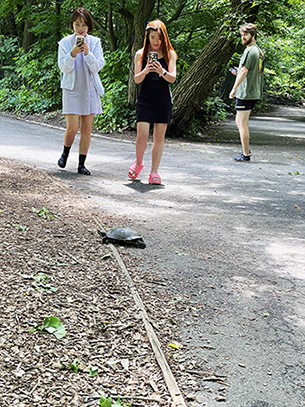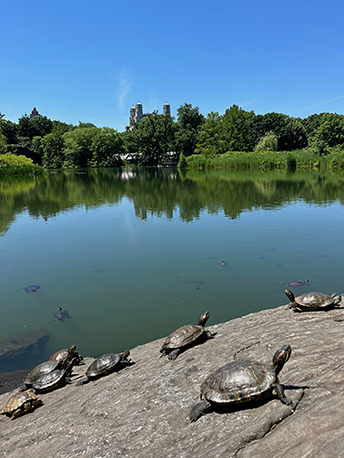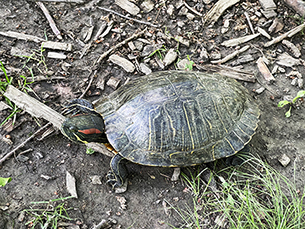June 29th, 2024
Central Park as Turtle Nursery
Spring is almost over, and I am looking back on a fortuitous natural history lesson I experienced recently.
It was a beautiful May day in Central Park. Sunshine was illuminating the freshly opened bright green leaves where only a few migratory birds remained from the seasonal flight up the Atlantic flyway, which generally is over by this time. Being an insectivore, a late-migrating Black-and-white Warbler was moving downward along the trunk of a red-oak tree (querqus rubra), pecking between the interstices in the ribbed rough bark where insects might be snagged for a meal. Another Wood Warbler, the American Redstart, a black-and-orange bird with a white underside, was being observed by a group of binocular-toting birdwatchers nearby. Mainly I was watching the flow of park visitors along the path beside the bench where I was sitting: friendly dogs on leashes, friendly parents of babies in carriages, and friendly partners holding hands as they strolled by. With my mobile phone I was garnering a few shots of this pleasant scene to post on Instagram.
As a tag-along birder, I sometimes flock with this breed of naturalist, but on this day I looked down at the path running alongside the bench where I was sitting. With awed incomprehension I began observing from its flat bottom and a domed upper carapace inscribed with olive green and light brown lozenge-shaped markings that I was staring at a medium-size turtle inching its way along the path in front of me. Looking up close I saw that it had an outstretched neck and large head distinguished by a red stripe on each side of the thread of yellow pigment beneath its protruding eyes. I later learned from my online investigation that the common name of “slider” is due the way this species slides off protruding rocks and logs into the water, its natural habitat. Its dark green head, tail, and legs have narrow black and yellow irregular stripes and its webbed feet have claws that are able to pull feet, tail, and head inside their shells.
Further instruction by Wikipedia taught me the following:
Red-eared sliders are medium-size turtles, growing approximately 12 inches long, with male turtles being somewhat smaller than females but having longer tails. They have webbed feet and are excellent swimmers. At night they sleep underwater, usually resting on the bottom or floating on the surface, using their inflated throat as a flotation aid.
As for diet, these turtles are omnivorous – eating a variety of plants, insects, snails, minnows, and other small aquatic prey. Regarding their sensory abilities, Red-eared sliders have poor hearing but are very sensitive to vibrations. Their eyesight and sense of smell are well-developed. Nerves throughout the carapace make them sensitive to the touch.
In terms of reproduction, courtship is a male ritual that involves swimming around the female fluttering or vibrating its long claws around her face or head. Subsequent mating takes place underwater. After copulation, the female leaves the water and begins an expedition across dry land in search of a patch of plain dirt or sand and minimal vegetation where she can dig a shallow depression in the ground that serves as a nest for depositing the eggs that will produce turtle fledglings.
_
My first-hand knowledge of Central Park as a Turtle nursery was until now limited to my serendipitous discovery in Spring, 2022, while sitting by a small patch of unplanted land next to the Boat Landing at Wagner Cove I spotted about a dozen circular dish-like indentions in the ground and in front of me three turtles clawing away in order to add three more.
Now, two years later with a bit of online research in hand, I watched the turtle I had just sighted beside my park bench move under it and onto the grassy meadow behind me. I surmised that this creature, which appeared to be a smoothly domed, geometrically etched mobile rock, was a female red-eyed slider engaged in the exploratory beginning of her maternity odyssey. This made sense inasmuch as Bank Rock Cove was only a short distance in front of my park bench and therefore the meadow behind it might be a plausible location for a nest-building red-eyed slider.

Red-eared slider crossing a path in the Ramble.
While still sitting on my bench I continued to watch this anomaly of nature, a turtle moving uphill at a slow crawl on the path in front of me. As park pedestrians stepped over and around it, I became eager to find out if the same birthing-preparation scene I had previously observed at Wagner Cove was going on here. Based on my conjecture that the turtle in sight was a female that had crawled out of the nearby arm of the Lake known as Bank Rock and migrated upland in search of a congenial site in which to dig in order to remove a surface layer of soil and random debris from the ground in order to create one or more shallow nests, I decided to stalk her as she moved across the grassy meadow toward its northern border.
Getting up from my bench, I began to follow this presumably mature female red-eyed slider as she moved across the grass to the sparsely vegetated berm of the Seventy-ninth Street transverse Road where her hind legs would scoop out dirt to make nesting sites in which she would, according to Wikipedia, lay between two and twenty round white eggs and then cover them up with the excavated debris.
Further instruction from Wikipedia professes that “incubation lasts approximately sixty to 100 days. The hatching uses the chick’s canuncle (eye tooth) to break open the shell. Soon after hatching the eye tooth disappears, and young turtles are born having to take care of themselves.”
_
Before putting myself in the wake of the turtle as it moved across the meadow, I consulted my iPhone Safari browser where I discovered that I was watching the slow progress of a red-eared slider, an invasive semiaquatic turtle belonging to the family Emydidae, which turns out to be “the most popular pet turtle in the United States and also popular as a pet across the rest of the world.
Further Facts

Turtles sunning beside Turtle Pond in Central Park.
Males are smaller than females but their tails are longer. Red-eared sliders are cold-blooded and must leave the water to sunbathe in order to regulate their body temperature. For direct evidence of this, you can stand beside the coping of the terrace that encloses Belvedere Castle atop Vista Rock looking look down at the water body christened Turtle Pond by former Parks commissioner Henry Stern. Here, almost any time of the year, you may see a multitude of Red-eyed sliders swimming around and settling at a mass gathering site where they pack themselves together carapace-to-carapace on a couple of large flat-topped, water-level adjacent boulders that are part of the foundation of Vista Rock. Take a count and you will see on one rock slab a congregation of nine or ten turtles at a time and next to them a single turtle that is climbing out of the water and trying to squeeze into the pack. They appear to be sun-bathing as they sprawl en masse on reasonably warm, sunny days, but, as stated above, the true reason for this is the fact that they are cold-blooded and must leave the water to sunbathe in order to regulate their body temperature.
Another park site for mass turtle watching is the large shoreline outcrop of Manhattan schist that fastens the waterside folk-dancing area opposite the equestrian monument of King Władysław II Jagiełło, King of Poland, to the eastern edge of the pond where you may find yourself to be almost a sun-bathing turtle yourself if you step down from the bluestone dancing terrace to a large outcrop of flat-topped Manhattan Schist with gleaming sparkles of mica reflecting the sunlight. Here, instead of being a Belvedere balcony spectator of the red-eyed sliders massed together near the west arm of Turtle Pond, on its eastern shore you can have a first row seat in the Orchestra and get as close as you wish to photograph them en masse.
_
Now, I must circle back to the single red-eared slider that I saw from the bench where I was sitting beside the path leading from the West Drive to the Central Park Ramble and then followed as she made her way across the meadow to the berm of the Seventy-ninth transverse road, which under the circumstances could be surmised to be a maternity room. Pacing my steps to her turtle-speed waddle, I stopped whenever she stopped. At several places I watched her scratching vigorously enough to tear up some of the grass and, next to the sunken transverse’s south berm, I observed her scrabbling in a patch of un-vegetated dirt.

Red-eared slider attempting to build nest.
Now I realized that the turtle was applying the same nest-creation technique as the one I had seen earlier at Wagner Cove. We were now just above the 79th Street Transverse Road at the opposite end of the meadow across from the bench on which I had been sitting when I first noticed the turtle and beyond it the clump of trees that grow on the slope going down to the northwestern lobe of the Lake, a cove known as Bank Rock, which lies just north of Oak Bridge. The light dawned: Of course, turtles are aquatic and the Lake’s Bank Rock cove being the primary habitat of this one.
With more help from Wikipedia, I learned the following:
Biological Behavior: Mating takes place under water. After mating, the female leaves the water and uses her hind legs to dig a nest hole in the soil or sand. She lays between 2–30 white round eggs and then covers them up. Incubation lasts for about 60–100 days. The hatchling uses its caruncle (egg tooth) to break open its shell. Soon after hatching this tooth disappears. Young turtles are born having to take care of themselves.
Universal Habitat and Range: The red-eared slider is a subspecies of the pond slider, a semiaquatic turtle belonging to the family Emydidae. It is the most popular pet turtle in the United States, is also popular as a pet across the rest of the world, and is the most invasive turtle. Red-eared sliders inhabit areas with still, warm water – creeks, lakes, ponds, streams, swamps- or slow-flowing rivers. They are native to eastern and central United States and northern Mexico. They have become established in other places because of pet releases and now they are an invasive species in many areas.
Scientific name: Trachemys scripta elegans.
Lifespan in captivity: 40 years.
Biologica: Red-eared sliders are cold-blooded and must leave the water to sunbathe in order to regulate their body temperature. They are excellent swimmers. At night they sleep underwater, usually resting on the bottom or floating on the surface, using their inflated throat as a flotation aid.
Diet: These turtles are omnivorous – eating a variety of aquatic plants, insects, snails, fish, and other small aquatic prey.
Senses: Sliders have poor hearing but are very sensitive to vibrations. Their eyesight and sense of smell are well-developed. Nerves throughout the carapace, make it sensitive to touch.
Communication: During mating season, the courtship ritual by the male involves swimming around the female fluttering or vibrating his long claws around the female’s face or head.
Reproduction: Mating takes place under water. After mating, the female leaves the water and uses her hind legs to dig a nest hole in the soil or sand. She lays between 2-30 white round eggs and then covers them up. Incubation lasts for about 60-100 days. The hatchling uses its caruncle (egg tooth) to break open its shell. Soon after hatching the eye tooth disappears. Young turtles are born having to take care of themselves.
Status: Listed as Least Concern on the IUCN Red List. Red-eared sliders are included in the List of the World’s 100 most invasive species published by the International Union for the Conservation of Nature.
Share
